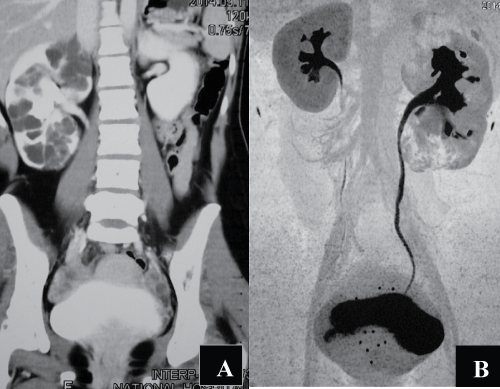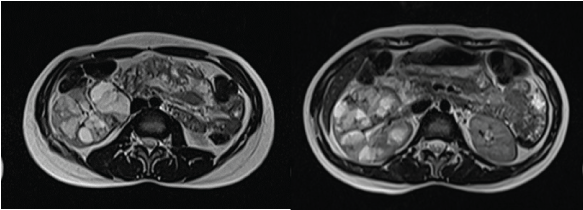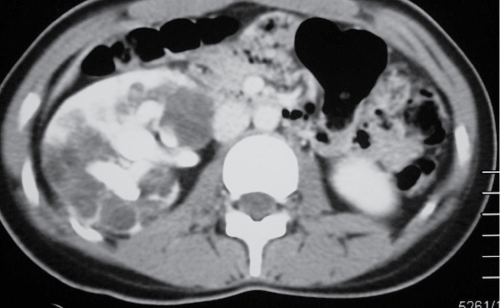International Journal of Radiology and Imaging Technology
Unilateral Renal Cystic Disease: A Case Report of A Rare Disease and Review of Literature
Rushani T Samarakoon* and Thamara Rajapakse
Department of Radiology, National Hospital of Sri Lanka, Sri Lanka
*Corresponding author:
Rushani T Samarakoon, Department of Radiology, National Hospital of Sri Lanka, Sri Lanka, Tel: 94774525960, E-mail: rushani1980@gmail.com
Int J Radiol Imaging Technol,
ijrit-1-001 (Volume 1, Issue 1),
Case Report
Received: June 6, 2015: Accepted: July 26, 2015: Published: July 28, 2015
Citation: Samarakoon RT, Rajapakse T (2015) Unilateral Renal Cystic Disease: A Case Report of A Rare Disease and Review of Literature. Int J Radiol Imaging Technol 1:001
Copyright: © 2015 Samarakoon RT. This is an open-access article distributed under the terms of the Creative Commons Attribution License, which permits unrestricted use, distribution, and reproduction in any medium, provided the original author and source are credited.
Abstract
Unilateral renal cystic disease (URCD) is a rare entity with few reported cases. This condition is often misdiagnosed for other cystic renal diseases like autosomal dominant polycystic kidney disease, cystic dysplastic kidney disease and cystic nephroma. Nevertheless, this is a benign entity with a potential for good prognosis. Imaging features, supported by background clinical and biochemical findings, diagnosis of URCD is possible. A case of URCD is reported here, having diagnosed on imaging features and followed up conservatively.
Introduction
Unilateral renal cystic disease (URCD) is a rare cystic renal disorder. It is characterized by affected kidneys having multiple cysts, normal excretory system and a near normal contralateral kidney. It is not related to autosomal dominant polycystic kidney disease (ADPKD) [1,2]. There is no genetic predisposition, renal function deterioration or extra renal manifestations [1,2]. Knowledge of imaging features, with supportive clinical and biochemical evidence, help radiologist to arrive at the correct diagnosis and appropriate follow up. We report a case of URCD diagnosed by computed tomography (CT) and magnetic resonance imaging (MRI) characteristics.
Case Presentation
Seventeen year old female patient was presented with intermittent right sided abdominal pain for 6 months duration. No family history of renal disease was identified. Physical examination was unremarkable. Her blood pressure was 110/70mmHg.
Biochemical investigations, including serum creatinine, full blood count, and urinalysis were normal. Her serum creatinine was 0.6mg/dl.
On abdominal ultrasonography (USS) the right kidney was enlarged with a bipolar length of 12.4cm. There were multiple cysts of varying sizes involving cortex and medulla of the right kidney and some of them having mural calcification. Ultrasonically the left kidney was normal. There were no cysts in the spleen, pancreas or liver.
Technetium-99m-dimercaptosuccinic acid (DMSA study) showed reduced tracer uptake in the right kidney. Differential renal functions were 65% in left kidney and 34% in right kidney.
Contrast enhanced abdominal CT (CECT) scan revealed enlarged right kidney with multiple cysts, of varying sizes without capsular formation. It showed enhanced intervening normal renal parenchyma (Figure 1A) with normal pelvicalyceal system and ureters (Figure 1B). CT scan confirmed that there are no cysts in the contralateral kidney or other abdominal organs (Figure 2).

.
Figure 1: CECT abdomen (A) coronal image demonstrating multiple simple cysts in Right kidney and normal left kidney and (B) CT urography image (posterior) showing normal excretory system of right kidney.
View Figure 1
MRI scan too confirmed, evidence of enlarged right kidney (BPL 13cm) with multiple renal cysts (Figure 3) with preservation of the normal renal configuration. There were no solid masses or thick septae in cysts.

.
Figure 3: Axial T2 weighted MRI images showing multiple cysts in the right kidney.
View Figure 3
Based on the clinical, biochemical and imaging findings, and the absence of family history of renal cystic diseases, the patient was diagnosed as URCD. Follow up with imaging is recommended to evaluate possible complications of renal cysts.
Discussion
Unilateral renal cystic disease is a rare entity, first described in 1964 as unilateral polycystic kidney disease [3]. In 1979 Cho et al., first proposed this condition as a separate entity from ADPKD [4]. Whereas, Levine et al. [5], in 1989 named the condition as unilateral renal cystic disease. There are only 63 reported cases in the literature [4]. Radiological and clinical features of recently reported cases in the literature are summarized in table 1. Clinically, these patients present with hypertension, flank pain, hematuria or a flank mass.
![]()
Table 1: Cases of URCD reported in the literature with emphasis on radiological imaging features.
View Table 1
Imaging findings vary depending on the degree of involvement. Cysts can involve only a segment of the kidney or the whole kidney. Solack et al. [6] and Neyaz et al. [4] reported two cases of localized or segmental form of URCD and other reports are of diffused disease as in our case. Ultrasonography displays multiple cysts of various sizes, which may appear complex due to intervening parenchyma, simulating septae of a cystic nephroma. There can also be scattered focal mural calcifications in the cyst wall [4].
Conventional, CT or MR urography demonstrates distortion of the pelvicaliceal system. However, the affected kidney shows normal excretion despite a significant portion of the kidney being replaced by cysts [4]. Hazarika et al. [7] also reported that the excretory system is normal despite pelvicalceal distortion. CT or MR imaging best reveals the cystic nature of this renal disease [4] and background supportive features to arrive at a correct diagnosis.
URCD need to be distinguished from other cystic renal conditions such as ADPCKD, cystic nephroma and cystic dysplastic kidney diseases [8].
Although URCD demonstrate similarity to ADPKD, it is different from ADPKD. As URCD is a non-familial, non-progressive and a unilateral entity with absence of pancreatic, splenic or liver cysts and other organ abnormalities like colonic diverticuli and berry aneurysms in the circle of Willis [7,8]. Similar findings were seen in our case and in most of the cases reported in the literature.
In our patient, family screening using USS was negative for ADPKD and she did not show extra renal manifestations of ADPKD. Most of the cases reported in literature also confirm negative family history normal renal functions. Bae et al. [9] and Hwang et al. [2] as in this case, screening was done using USS whereas, other cases in the literature were reviewed clinically. URCD shows fairly a benign course, compared to ADPKD. Associated renal cell carcinoma has not been reported so far. Due to prognostic and genetic implications, differentiation of these two entities is imperative.
Enhancing and compressed renal tissue in URCD can mimic enhancing septae of a complex cyst in CT. Therefore, in the segmental form of URCD cystic renal cell carcinoma needs to be excluded [9]. Discrete, encapsulated masses in the latter condition would be a distinguishing imaging feature. Non encapsulated nature of cysts and preservation of reniform configuration in URCD is described as a defining radiological feature in Park et al. [1] and Bae et al. [9] as well.
In URCD collecting system is continuous, thus facilitating the differentiation from cystic unilateral dysplastic kidney diseases in which, the affected kidney is non-functional and ureters are atretic [9].
Most patients of URCD are commonly diagnosed in adulthood, although children and even infants and neonates have been reported in the literature.
URCD, due to its benign nature can be managed conservatively, biochemical and radiological surveillance to follow up is sufficient. This was the protocol used in most of the reported cases except, for a few, which offered nephrectomy to control symptoms.
Conclusion
URCD is rare, but is a benign condition with a relatively good prognosis. Imaging together with clinical and biochemical evidence can differentiate it from other similar morphological conditions like ADPCKD, cystic nephroma and cystic dysplastic kidney diseases with a relative certainty. Knowledge of this condition helps in arriving at correct diagnosis, thus minimizing unnecessary investigations and patient and family reassurance.
References
-
Park BS, Kim TH, Lim SJ (2007) Unilateral renal cystic disease. Korean J Urol 48: 652-654.
-
Hwang DY, Ahn C, Lee JG (1991) Unilateral renal cystic disease in adults. Nephrol Dial Transplant 14: 1999-2003.
-
Bergman H, Nehme DA (1964) Unilateral polycystic renal disease. N Y State J Med 64: 2465 -2469.
-
Neyaz Z, Kumar S, Lal H, Kapoor R (2012) Localized cystic disease of the kidney: A rare entity. J Radiol Case Rep. 6: 29-35.
-
Levine E, Huntrakoon M (1989) Unilateral renal cystic disease: CT findings. J Comput Assisted Tomogr 13: 273-276.
-
Aynur Solak, Mehmet Serkan Gür, Berhan Genç (2013) Localized Cystic Disease of the Kidney: A Rare Cause of Hypertension in a Young Adult. Journal of Clinical Imaging Science 3: 33.
-
Manoj Hazarika, Nabanita Deka, Gautam Goswami (2014) Unilateral Cystic Renal Disease with Diffuse Involvement of Kidney: A Case Report. Journal of Evolution of Medical and Dental Sciences 3: 12217-12220.
-
Ana Farinha, José Assunção, José Vinhas (2011) Unilateral renal cystic disease: report of an additional case of a rare disease. Port J Nephrol Hypert 25: 163-165.
-
Eun Hui Bae, Young-Hwan Hwang, Soo Wan Kim (2013) Unilateral renal cystic disease in the right kidney. Int Braz J Urol 39: 435-437.






